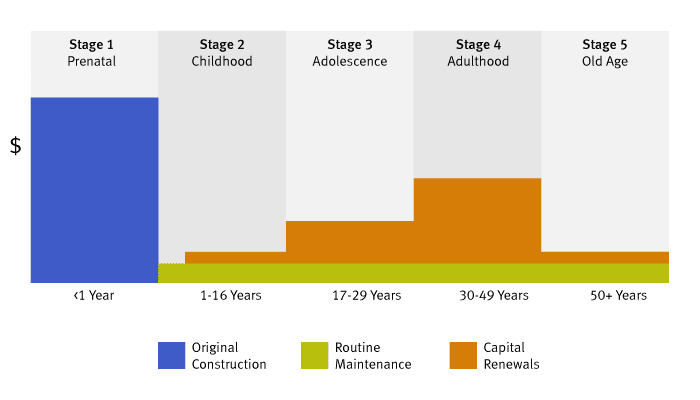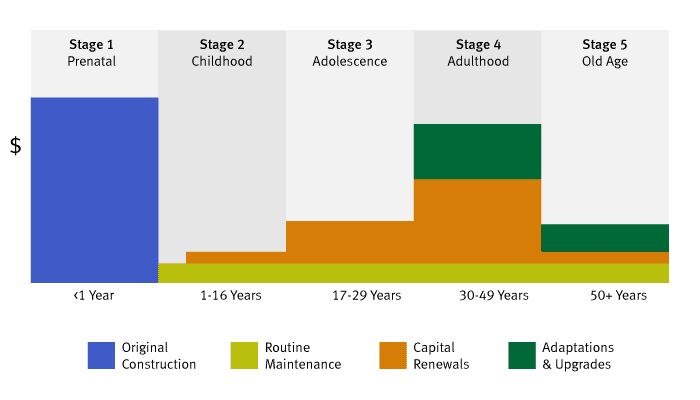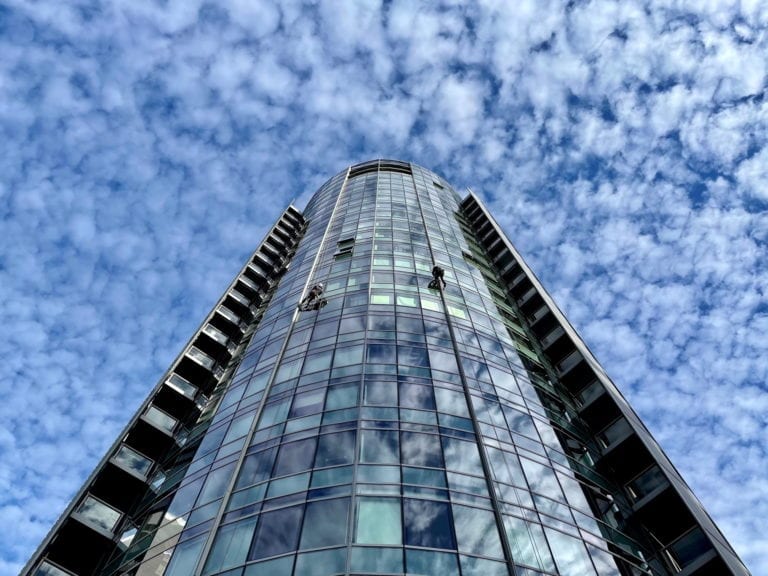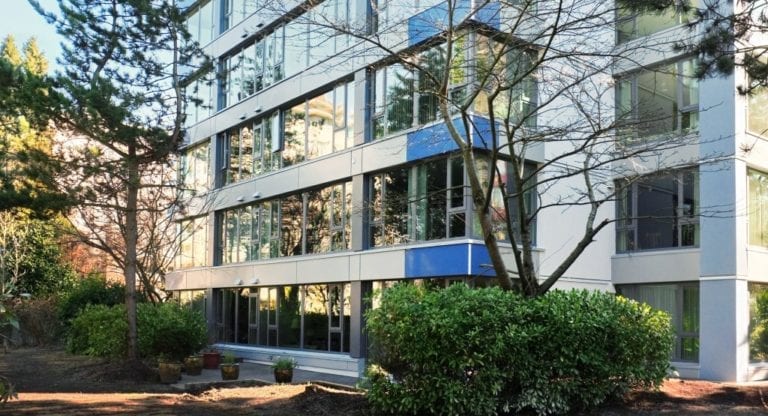Every building is unique. The need for maintenance, repairs and asset renewals varies depending on many factors, including: the quality of construction, design details, exposure conditions and the standard of care given by the owners and their facility management team.
Notwithstanding the differences between individual buildings, it has been determined that many buildings follow a similar pattern as they pass through different stages in their respective life cycles. In this regard, five general life cycle stages have been identified and, using the analogy of the human body, they are summarized conceptually in the figure below.
Although these life cycle stages are generalizations they enable owners and managers to anticipate future capital renewal requirements and to make informed decisions about budgeting and other resources for maintenance, repairs and asset renewals.
From the figure we see that maintenance costs are generally consistent over the life a of building; however, asset renewal expenditures vary dramatically at different times, particularly during facility life Stage-3 and Stage-4. The requirements for effective stewardship of the facility are similar for all types of property, whether it is a high-rise building, low-rise building, fire station or office building. We can categorize the life stages as follows:
- “Pre-Natal” (under 1 year). During this stage, the building is in the process of being handed over from the developer to the first owners. The assets are new and are covered under a variety of warranties. Maintenance requirements are focused on cleaning activities and periodic inspections
- “Childhood” (1-16 years). During this period, the owners have assumed full responsibility for all the maintenance, repairs and long-range renewal planning for the building. With two years of expenditure experience, the owners have established a preventive maintenance program and are allocating monies to the long-range reserve fund. The owners are starting to address some relatively small renewal projects, which are addressed in more detail in the next section.
- “Adolescence” (17-29 years). It is during this 3rd stage that the owners may find that the maintenance budgets established during the 2nd life stage are no longer adequate to address the impending replacement of building assets that have deteriorated and reached the end of their useful service lives. This phase is represented by a noticeable increase in the number of capital renewal projects. This life stage often compels owners to seriously reconsider their historical budgeting practices and to make more reasonable funding allocations for asset renewals as the building moves through life Stage-3 and into Stage-4.
- Adulthood (30 to 49 years). The largest and most expensive of all asset renewal projects tend to occur during the 4th life stage. As a result, significant funds will need to be reinvested in the building and the standard operating and maintenance budgets will need to be revisited. Some of the assets have been replaced over the preceding 30-40 years and the owners and manager are now operating a building with assets at a variety of different ages. There is no longer a single baseline and the facility managers are tasked with tracking the different assets.
- Old Age (50 plus years). At this juncture, all the major assets have been through one renewal cycle. Therefore life Stage-5 is essentially a return to life Stage-2. The owners must now prepare for the next cycle of asset renewals as the building moves beyond its 50th anniversary and embarks upon the next 50 years of operations.
We will now explore each of the five life-cycle stages in further detail, paying particular attention to maintenance, repair and renewal requirements at each stage.
1. “Pre-Natal” Stage (Under 1 year)
The first life stage of a building occurs up to the end of the first (or second year), depending on the types of warranties on the project.
- Maintenance. The primary focus at this stage is to conduct the prescribed maintenance to preserve the warranties on the new assets, which also includes inspections to identify any warranty defects. During this stage, some young strata corporations struggle to establish appropriate maintenance procedures, including a full slate of maintenance service contracts and maintenance log-books to demonstrate that the necessary due diligence is being done.
- Repairs. Under normal circumstances, the owners should not be incurring any significant costs for repairs during this very young stage of the building’s life. When repairs are necessitated, they can be controversial and may result in disputes with the developer and other parties over whether or not these are covered by the warranties. It is important that the owners receive advice from their consultants on how to differentiate between legitimate warranty defects, normal wear and tear and other such matters.
- Renewals. Barring any unusual circumstances, there should not be any asset replacement projects during this early stage in the life of the building. If an asset requires replacement then it has likely occurred as a result of premature failure, misuse or abuse by the owners, force majeur or perhaps some insurable loss.
The “pre-natal” stage essentially ends when the initial one-year, 15-month, and/or two-year warranties have expired. The additional longer-term warranties, such as five- and ten-year warranties, are addressed as part of the building’s transitions into the “childhood stage”.
2. “Childhood” Stage (2-16 years)
The second life stage of a building can be considered to start on, or about, the 2nd anniversary and extends until about the 16th year. In very general terms, the childhood stage is characterized by the following:
- Maintenance. Standard operating and maintenance budgets are typically adequate to operate the building. The strata corporation has now been through two years of teething procedures and should have established the necessary and sufficient preventive maintenance program. Maintenance tasks are focused on a combination of cleaning activities, inspection activities and small miscellaneous repairs. The owners must be careful not to become complacent during this life stage of the building – large expenditures are looming on the horizon and preparations made at this early stage will mitigate the impact of these.
- Repairs. During the first five years, the owners should continue to focus its efforts on preserving the remaining warranties on the assets. A number of relatively small repair projects will arise but these should not have any major impact on the operating budget.
- Renewals. Even the best-designed buildings, using the best quality materials, contain a few assets that have short lives. During Stage-2 the owners will be confronted with a few assets that require replacement. These are typically small projects of relatively low capital cost. However, since these are the first renewal projects in the building, the owners may be taken by surprise and may not be able to put the projects into their proper perspective. These renewal projects do not necessarily mean that the building has problems – rather, the owners must understand that some assets have short service lives. The owners/managers may choose to seek the advice of professionals to determine appropriate scopes of work and obtain competitive bids.
Listed below is a summary of some of the renewal projects that may occur during the second stage in the life cycle of a facility:
- Water Heaters. Many building owners are familiar with the replacement of gas-fired water heaters. Unfortunately, some facilities have undergone multiple water heater replacements during the first 16 years of a building’s life and consideration is sometimes given to replacement of the short life water heaters with a more durable system such as a boiler and storage tanks.
- Circulating pumps. Low-rise and high-rise buildings are equipped with one or more very small fractional horsepower circulation and recirculation pumps that distribute domestic hot water through the building. Since these pumps run continuously, they are often replaced on a 3-10 year cycle, depending on the quality of the pump.
- Gate Motors. The vehicular entrances to parking garages are usually high traffic locations that sustain wear from repetitive cycling of the doors. Depending on traffic loads, these are typically replaced every 3-10 years.
- Exterior Repainting. Some of the exterior cladding and finishes, particular wood trim, wood siding and wood fences will require repainting/restaining to preserve their integrity and aesthetic appearance. The frequency and scope of repainting projects is determined by exposure conditions.
Some additional projects that may occur during this stage are: exterior sealant renewals, balcony membrane resurfacing, hallway carpeting replacement and sump pump overhauls.
It is important to recognize that the short-life assets (ie., those assets with useful service lives of 10 years or less) will continue to require cyclical replacement during all the subsequent life cycle stages of the building. These projects can be a nuisance and frustrating for the owners; however, they do not seriously impact the financial bottom line when we consider the big-picture view over the life a building.
READ: RDH Existing Buildings Services
3. “Adolescence” Stage (17-29 years)
The third life stage of a building is represented by a dramatic shift in the number of challenges that face the owners. During the earlier life stages, the owners were able to respond to problems as they arose from time-to-time. The 3rd life stage requires owners to be even more vigilant and to take additional care to be proactive in the management of the assets. The significant increase in the number of asset renewal projects at this life stage is not necessarily indicative of problems with the building but rather necessitated by the age of the assets, many of which will now be nearing the end of their design service lives.
This stage in the building’s life cycle is characterized by following:
- Maintenance. Maintenance continues to be focused on all critical assets such as sump pumps, elevators, fire alarm systems and roofs. In addition, particular attention must be paid to exterior sealants and the various service penetrations through the walls and roofs.
- Repairs. This is the stage at which different types of obsolescence start to occur. For example, some assets, particularly electronic components, may be prone to technological obsolescence and are no longer manufactured, making it difficult to find replacement parts. The different forms of obsolescence and how to manage them will be discussed in a future information bulletin.
- Renewals. Many assets are designed with a 20-25 year useful service life and are therefore considered to be mid-life assets. This is one of the primary reasons why reserve fund studies include a 30-year planning horizon (ie., the window into the future). This enables the owners to anticipate and prepare for the majority of the asset replacement projects. The ability of owners to fund these capital expenditures can have a significant impact on the future lifespan of the building.
Listed below is a summary of the types of renewal projects that may occur during the third stage in the life cycle of a building:
- Re-Roofing. Many flat (low slope) roofs, and some pitched roofs, have a useful service life of approximately 20-25 years. Even the best roofs, with good maintenance, will still need to be replaced during this life stage.
- Elevator Modernization. Elevator systems generally require modernization of the control equipment after about 20 years.
- Heating Boilers. Many boilers are designed with an approximate 20-year service life and it is not uncommon for owners to replace the boilers at this stage in the life of the building.
- Plumbing Distribution Systems. Many building with copper plumbing distribution pipes have undergone re-piping or relining projects. Some strata corporations have installed acid neutralization (water filtration) systems to mitigate the deterioration of the copper pipes.
Some additional projects during this stage include: exterior sealant replacement, replacement of failed sealed glazing units, and overhaul of sump pumps.
In some cases, a few of the projects that would typically occur in life stage 3 may be delayed until the 4th life stage. However, the ability to achieve the full service life from the assets will depend on the quality of the maintenance that the owners have performed during the first 30 years of the building’s life.
4. “Adulthood” Stage (30-49 years)
The fourth stage of a building starts at about 30 years. Some of the shorter life assets (that were first replaced in life stage 1) will now require their second round of renewal. The owners and their property manager are now challenged with a facility containing a range of assets of different ages and deteriorating at different rates. Stage 4 of the building life cycle is characterized by the following attributes:
- Maintenance. Maintenance during this stage is essentially no different from the earlier life stages. The owners continue to focus on the maintenance of all critical systems. The quality of the preventative maintenance program will help mitigate the rate of deterioration of some of the assets.
- Repairs. Functional obsolescence, style obsolescence and legal obsolescence need to be managed carefully at this stage. Also, the factors impacting the deterioration of assets will be discussed in an upcoming bulletin.
- Renewals. At this stage the owners will encounter the largest and most expensive of the asset renewal projects, such as the replacement of the windows and wall cladding assemblies.
Listed below is a summary of the types of renewal projects that often occur during the “adulthood“ life stage of a building:
- Exterior Cladding. Some exterior wall cladding assemblies will reach the end of their useful service lives and require renewal during this life stage.
- Fire Alarm Panels. Fire alarm systems are prone to technological obsolescence, which affects the availability of replacement parts. The replacement of the panel can sometimes trigger the need to replace all the field devices throughout the building, such as smoke alarms and heat detectors.
- Exterior Roadways. After 20-30 years of continued exposure, the asphalt roadways and concrete paved areas will likely require rehabilitation. Signs of deterioration will include alligator cracking and potholes.
- Interior Redecorating. Style obsolescence sometimes drives the need to replace interior finishes and furnishings in the lobbies, hallways and amenity rooms.
READ: From Building Rehabilitation to Deep Energy Retrofit
5. “Old Age” & Beyond (50+ years)
The 5th life stage of a building starts at about 50 years. It is important to note that there is no direct correlation between the age and the condition of a building. Some older building can be in very good condition as a result of the owners having replaced the assets at the ends of their useful service lives. Similarly, some young buildings may be in poor condition due to inadequate maintenance or premature failure of some assets.
Most buildings will continue to operate for many decades beyond Life Stage-5. The necessary and sufficient maintenance during each life stage, coupled with timely renewal of assets, will ensure that the owners receive many decades of good value from their real estate investment.
Managing the Life Cycle Stages
There are two tools that are most valuable to help the owners manage the asset during each of the five life cycle stages. These are:
- Maintenance Plan. The maintenance plan helps the owners control what happens at each life cycle stage by ensuring that adequate maintenance is performed to achieve the full service life from the assets.
- Reserve Study. The reserve study (or Depreciation Report or Capital Plan) helps the owners predict when the assets are likely to reach the end of their useful service life and to set aside sufficient monies in the reserve fund to offset the financial hardship of special levies. Request a free Depreciation Report Proposal from RDH.
Question: In an upcoming post we will try to tackle the question of how long should buildings last?
Please feel free to add your comments below. There is so much that we still need to understand about the life cycles of buildings.




